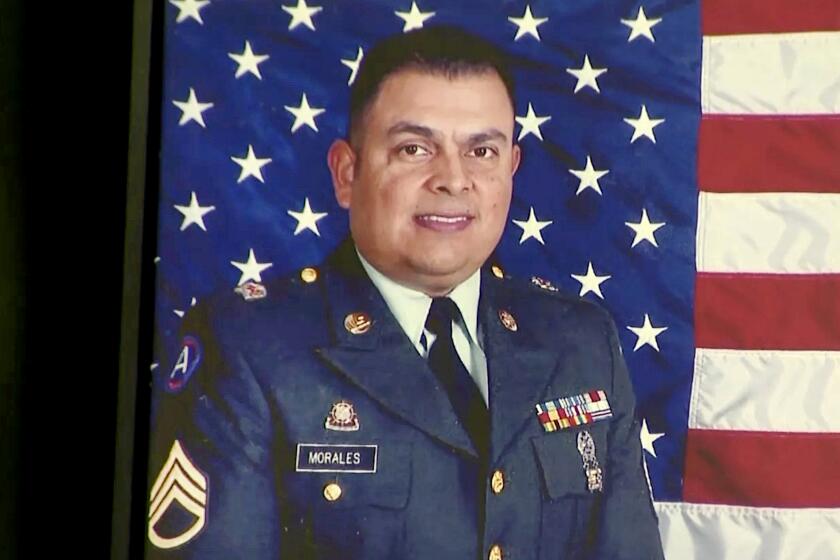Leonardo Da Vinci may be at the heart of a real art mystery
At three o’clock on a cold December morning, a team of researchers huddled together on scaffolding 25 feet high in Florence’s Palazzo Vecchio, holding a tablet computer up to a huge 16th century fresco.
But the researchers weren’t interested in the dramatic battle scene, the work of Renaissance artist Georgio Vasari.
Their goal was to solve one of art history’s greatest mysteries — whether Vasari preserved a long-lost work of Leonardo Da Vinci, “The Battle of Anghiari,” behind his own.
With the swipe of a finger, one used the tablet’s custom-built software to virtually peel away layers of pigment, plaster and brick, stripping the centuries-old wall to its bones. Drawing on decades of studies that shot energy through the wall at various wave lengths, it produced shadowy pictures of ancient fissures, bricked-over windows and a mysterious air pocket.
The research, described by team members and demonstrated in San Diego, is an attempt to use technology to accomplish something that has eluded art historians for centuries — determine the fate of the work.
Solving the mystery has been a 36-year obsession for lead researcher Maurizio Seracini, who runs UC San Diego’s Center of Interdisciplinary Science for Art, Architecture and Archaeology. The Florence native studied medicine and bioengineering before turning his technical expertise to art, and he has earned an international reputation for diagnosing ailments in the world’s great masterpieces.
But now, after decades of noninvasive study, Seracini’s team was using its high-tech tablets for a controversial purpose: to determine where to drill small holes through the Vasari fresco so tiny cameras could peer behind it.
Critics are accusing Seracini and his partners — the ambitious young mayor of Florence and a team at National Geographic, which is funding the quest in return for rights to a television documentary — of malpractice.
One government conservation expert monitoring the project resigned in protest. More than five hundred people — including leading art historians — signed a petition to halt the work. A local prosecutor opened a criminal investigation.
At its core, the controversy represents a clash of cultures: Seracini’s team of risk-taking techies intent on finding a lost masterpiece versus the starchy world of elite art historians determined to protect the known one. Seracini’s critics cast him as a modern Don Quixote on a sensationalistic quest. It doesn’t help that he is portrayed as himself, the art diagnostician in Dan Brown’s “The Da Vinci Code,” the bestselling novel scowled at by art historians for fueling an ill-informed obsession for all things Leonardo.
“It’s absurd to think that Vasari enclosed the Leonardo behind the wall,” said Tomaso Montanari, an art history professor at the University of Naples and the author of the petition. “It’s a little childish, like a Dan Brown conspiracy.”
Montanari and other opponents have denounced the project as being driven by marketing and politics. The evidence fueling Seracini’s search is circumstantial at best, they say, cobbled together from vague historical accounts and tantalizing but inconclusive scientific findings.
“Why should we be so impatient?” said Patricia Rubin, a leading Renaissance scholar who directs NYU’s Institute of Fine Art. “We’ve been waiting 500 years; why not wait another generation until we can actually do it with a noninvasive technique?”
Seracini is undaunted by the criticism.
“I’m very honored to search for the ultimate masterpiece,” he said recently via Skype from his Florence office. “If that means I’m Don Quixote, perhaps I am.”
The ‘Battle of Anghiari’
Florence in the early 1500s was the heart of the Renaissance, where artists and thinkers flourished under the patronage of the powerful Medici clan.
City leaders decided to commission two of history’s greatest painters to decorate the walls of the Palazzo Vecchio’s Hall of Five Hundred, the seat of government.
Michelangelo Buonarroti, a 29-year-old prodigy who had just completed his statue of David, sketched bathing soldiers being surprised by the enemy during the Battle of Cascina, the 1364 victory of Florentine troops over the Republic of Pisa.
Across the hall was his rival, the 52-year-old master Leonardo da Vinci, fresh from completing the “Mona Lisa.” He began painting a ferocious cavalry charge in which Florence had been victorious over Milan in the Battle of Anghiari in 1440. Neither work was completed.
Michelangelo was called to Rome by Pope Julius II to paint the Sistine Chapel. Leonardo abandoned his painting when his experimental technique — oil painted on a base of plaster mixed with wax or linseed oil — failed. In some areas, the colors ran together and the plaster separated from the wall.
Even so, for a decade the beauty of the unfinished works became, in the words of one contemporary, “the school of the world.” Michelangelo’s sketch was eventually destroyed by a rival. As late at 1549, there are accounts of visitors admiring Leonardo’s crumbling scene. It may have remained on the palazzo wall until the 1560s, when Vasari was commissioned to expand the hall and decorate its walls with frescoes.
Vasari adored the work of Leonardo, writing of the “Battle of Anghiari”: “It would be impossible to express the inventiveness of Leonardo’s design for the soldiers’ uniforms, which he sketched in all their variety, or the crests of the helmets and other ornaments, not to mention the incredible skill he demonstrated in the shape and features of the horses, which Leonardo, better than any other master, created with their boldness, muscles and graceful beauty.”
Would Vasari have destroyed a work he so admired? It would not have been unprecedented for him to have spared the painting: When Vasari created an altar for a Florence church in 1570, he carefully preserved a 15th century fresco behind it.
But for five centuries, art historians have assumed that Leonardo’s crumbling masterpiece was lost. All that is known to remain are preparatory sketches and copies made by admirers.
‘Cerca Trova’
Maurizio Seracini was a medical school drop-out in Florence when, in 1975, he ran into a former teacher, UCLA art history professor Carlo Pedretti, an expert on Leonardo.
Pedretti’s research had led him to believe that Vasari preserved the “Battle of Anghiari.” Might Seracini’s knowledge of ultrasound shed any light on the mystery?
Seracini was intrigued.
One day he was studying the fresco from a scaffolding and made a tantalizing discovery: Vasari had painted the words Cerca Trova, “seek and you shall find,” on a small flag. They were the only written words on all of Vasari’s frescoes. Seracini took it as a hint.
The project launched a new career for him, using technology to study art’s elusive properties. His work took him around the world, but he kept returning to the Hall of Five Hundred, where over the next three decades he used ultrasound, infrared, ultraviolet, microwave and other imaging technologies to search for the lost painting.
In 2000, he had a breakthrough: Using ground-penetrating radar, he discovered a small gap of 1 to 3 centimeters between the room’s original stone wall and the brick surface Vasari had added to support his frescoes.
The gap existed in only one section of hall — where Seracini believed Leonardo had painted his battle scene.
A Change in Plans
In mid-December at a research lab on the campus of UC San Diego, Falko Kuester was looking at a wall of 16 high-definition monitors showing a section of Vasari’s fresco several times larger than life.
“It’s actually better than being there,” said Kuester, a German engineer who worked in Silicon Valley before becoming the director of the research group Seracini launched in 2007.
Kuester grabbed a tablet computer off a table and, demonstrating what he had been doing in Florence just days earlier, pointed its video camera at the Vasari on the monitors. He used an “augmented reality” application made by a graduate student to overlay a thermal image that revealed a long dark patch — cold air seeping through where the fresco has cracked.
The researchers had hoped to conclude their search by evoking a ghostly image of Leonardo’s work using ionized radiation to determine precisely which pigments existed on the hidden stone wall. But building a neutron activation device proved beyond the budget of National Geographic, which has already invested hundreds of thousands of dollars in the project, and private fundraising fell short. After the meltdown of the Fukushima Daichi reactor in Japan, the notion of using radiation to find a lost painting in the middle of Florence became politically untenable.
Then, in mid-October, 36-year-old Florence Mayor Matteo Renzi notified the team that he and local cultural officials had decided on a simple and fast way to solve the mystery — drilling holes in the Vasari and inserting tiny cameras into the gap between the walls.
“I asked: How can I do this?” Seracini recalled. He eventually warmed to the idea, convinced that the Vasari could be protected by drilling only in areas where the painted plaster had already separated from the wall and required restoration. Six such sites were selected with local conservation authorities and the approval of cultural officials in Rome, Seracini said.
Given several nights to complete the work, the team scrambled to find fiber-optic cameras and a rig that would allow them to drill safely. High up on a scaffold, Italian conservators carefully lifted off 1-inch squares of the fresco and with a 6-millimeter bit bored six holes through the brick wall Vasari had built.
In each hole, Seracini’s team inserted a 4-millimeter endoscope and watched breathlessly on a nearby monitor.
For now, the results of those probes are being guarded jealously by Seracini’s team. They are likely to hinge not on dramatic images but on an analysis of whether samples taken from the wall contain pigments or resins known to have been used by Leonardo.
Of course, such evidence would raise new questions. If the painting is there, what can be done to rescue it without destroying the delicate Vasari?
“It’s not over,” Seracini said last month, smiling coyly.
More to Read
Start your day right
Sign up for Essential California for news, features and recommendations from the L.A. Times and beyond in your inbox six days a week.
You may occasionally receive promotional content from the Los Angeles Times.






